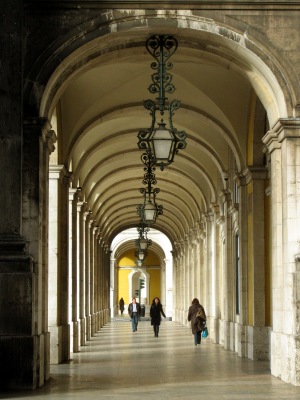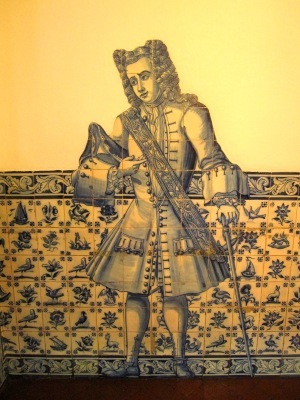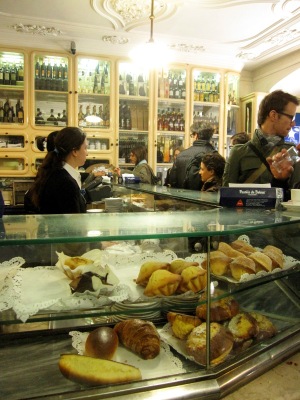Lisbon, seaside port and the commercial heart of Portugal. For centuries, Portugal wielded outsize influence beyond its borders through a vigorous policy of mercantilism and colonial exploration. From these waters, Vasco da Gama captained the first ships to set sail directly from Europe for India. Other explorers would reach the shores of South Africa, China and Japan. “Look, we have Spain on one side, water on the other. So everyone either has to fight, to conquer, or face the ocean and see what’s beyond,” said our guide, Victor Lamberto, head of Slow Food’s Alentejo chapter.
Unsurprisingly, this thirst for international travel resulted in lots of foreign exchange—in food, in language and in culture. As Lamberto guided us through the mosaic-covered streets and tiled walls of Lisbon, he remarked, “Lisbon has always attracted people from all over. Here, you do not find traditional Portuguese food, but a mix of influences. The Portuguese were the first to take food and flavors from one place to another in a global manner.” Today, the Japanese use the Portuguese words tempura for battered, fried foods and pan for bread, while the African chili pepper piri piri is commonly used in Portuguese cuisine.
If you hop on a tram in central Lisbon, in approximately 20 minutes you can reach Belém, a parish of Lisbon located about 6 km west of the city center. Hop off and check out the intricate limestone-carved Mosteiro dos Jerónimos (Jeronimos Monastery), which was built in the 16th century to commemorate Portugual’s first trip to India. It is a prime example of Manueline architecture, named after King Manuel I, and illustrates features from the sea and ships, such as knots, anchors and twisted ropes.
As it so happens, the monasteries of Portugual are not only architectural beauties, but also hotbeds of culinary excellence and innovation. Traditionally, the eldest son of the family would inherit all of the land and money, which meant that successive sons were left to fend for themselves, either in the military, nautical adventures or religious orders. Joining a monastic order did not mean relegating yourself to a life of austerity though. Since the church was one of the largest landholders in medieval times and supported by ample donations from the aristocracy, members of religious orders tended to eat very, very well. For instance, Belgian monasteries are widely celebrated for their beer brewing prowess.
In Portugal, the richest sweets and pastries have their origins in the kitchens of monasteries and convents, and tend to be heavily laden with eggs and sugar, both expensive ingredients at that time. Without a doubt, the most renowned pastry in Lisbon is the Pastéis de Belém, a treat that inspires smiles and chest-thumping from Portuguese locals and foreigners alike.
Unassuming from the outside, visitors slip under the blue awnings of the Pastéis de Belém bakery to find a whirlwind of confectionery activity. This shop and cafe employs 150 people, and sells 18-20,000 pastries a day. Their one day record for sales is 54,000 pastéis, sold on during the Lisbon half-marathon.
The recipe dates back 1837, from the aforementioned Jeronimos Monastery. When the Liberal Revolution of 1820 took place, the church lost much of its power, and eventually all convents and monasteries in Portugal were shut down in 1834. Desperate for money, the Jeronimos Monastery sold the pastéis de Belém recipe to a local shopkeeper, and the pastry has been a commercial success ever since.
Supervisor Maria Dulce took us into the back, where we intently watched white-capped women working puff pastry dough by hand in a highly unusual pulling and stretching technique. The dough was then cut into smaller pieces, molded into small rounds, and filled with creamy egg custard. The process is partly mechanized (I imagine that puff pastry presses are used to save time) but there are certainly touches of artisanal handiwork incorporated. We tried to ask for more detailed specifics on the pastéis recipe, but Dulce waved us off. “Right now, only three people know the secret recipe, and they must sign a form that obliges them not to tell anything. They are never together for dinner, and never drink the same wine to make sure the recipe will always be safe!”
My pastéis was warm from the oven, golden brown with a carmelized top and still puffy. I dusted the surface with an extra sprinkle of sugar and cinnamon and took a bite. Creamy center, crisp pastry crust, gone in seconds. I went back for another.
To be honest, I found myself comparing the pastéis de Belém to Chinese egg custard tarts, and having been raised on these since my diaper days, I think I prefer the latter. The Chinese egg tart has a thicker, chewier crust and a custard filling that is a little lighter and not as rich. Then again, there is ample reason to believe that the Chinese egg tart evolved from the Portuguese pastéis, perhaps through influence from the Portuguese colony of Macau.
Hankering for a taste of divine desserts? You’ll have to make your way to Belém because the pastéis are only sold here, to incoming foot traffic. Step in to taste a piece of history for just 90¢. On that particular morning, it was pouring rain and the shop was not too crowded, but be prepared to queue at peak times.









